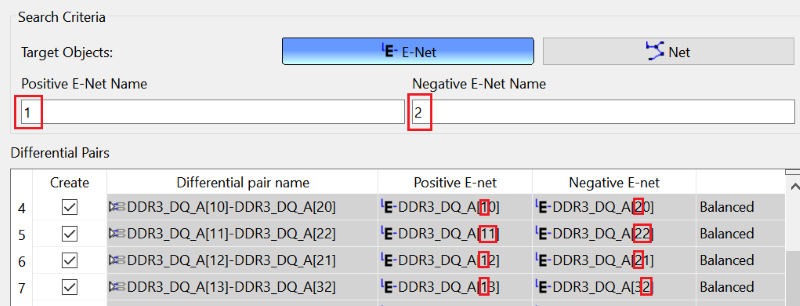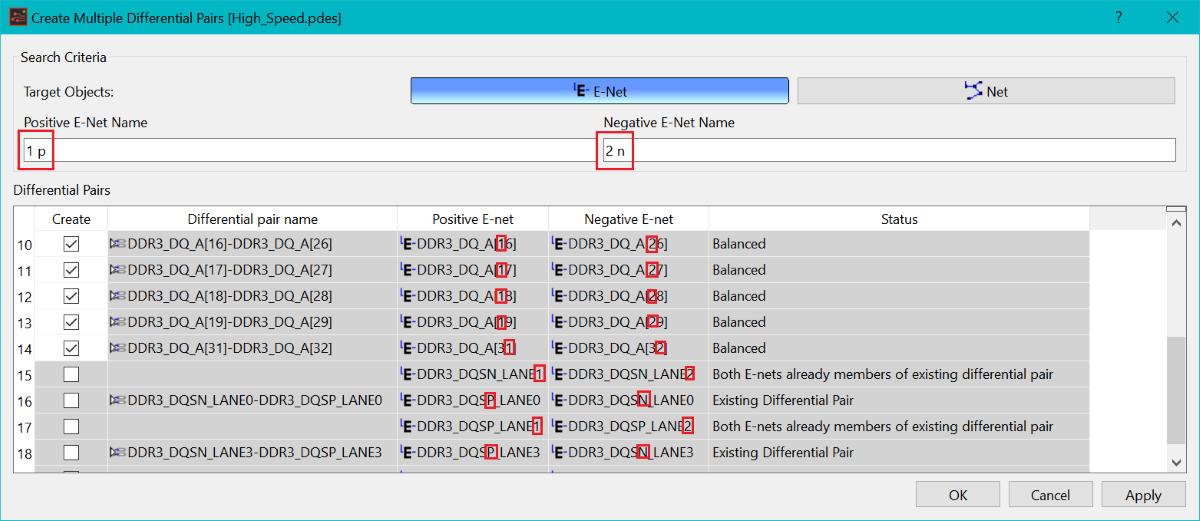The Create Multiple Differential Pairs dialog allows you to create multiple differential pairs from specified E-Nets. This is done by either specifying differences between the names of positive and negative E-Nets, or between the names of positive and negative nets. For E-Nets, specify the values that are different in the Positive E-Net Name and Negative E-Net Name boxes. For nets, specify these values in the Positive Net Name and Negative Net Name boxes. Suggested and existing differential pairs that match your criteria are displayed in the Differential Pairs table. The suitability of each one is indicated in the Status column. To display this dialog click Edit > Create Multiple Differential Pairs in Constraint Browser, or click Create Multiple Differential Pairs on the Constraint Browser ribbon.
Search Criteria
| Item | Description | |
|---|---|---|
| Target Objects | E-Net | If selected, then the Positive E-Net Name and Negative E-Net Name boxes are made available. These allow you to specify differences between the names of positive E-Nets and negative E-Nets. In the Differential Pairs table, positive E-Nets and negative E-Nets are displayed whose names are identical apart from the specified characters. |
| Net | If selected, then the Positive Net Name and Negative Net Name boxes are made available. These allow you to specify differences between the names of positive nets and negative nets. In the Differential Pairs table, positive nets and negative nets are displayed whose names are identical apart from the specified characters. | |
| Positive E-Net Name | Specify characters in the positive E-Net that define the differences between the names of positive E-Nets and negative E-Nets. Names are matched that are identical, apart from the specified values. Suggested and existing differential pairs that match your criteria are displayed in the Differential Pairs table. For guidance on defining these differences, see the Note section below. | |
| Negative E-Net Name | Specify characters in the negative E-Net that define the differences between the names of negative E-Nets and positive E-Nets. Names are matched that are identical, apart from the specified values. Suggested and existing differential pairs that match your criteria are displayed in the Differential Pairs table. For guidance on defining these differences, see the Note section below. | |
| Positive Net Name | Specify characters in the positive net name that define the differences between the names of positive nets and negative nets. Names are matched that are identical, apart from the specified values. Suggested and existing differential pairs that match your criteria are displayed in the Differential Pairs table. The E-Nets are displayed in the Differential Pairs table that are associated with each relevant net. For guidance on defining these differences, see the Note section below. | |
| Negative Net Name | Specify characters in the negative net name that define the differences between the names of negative nets and positive nets. Names are matched that are identical, apart from the specified values. Suggested and existing differential pairs that match your criteria are displayed in the Differential Pairs table. The E-Nets are displayed in the Differential Pairs table that are associated with each relevant net. For guidance on defining these differences, see the Note section below. |
In the Positive E-Net Name, Negative E-Net Name, Positive Net Name and Negative Net Name boxes, the specified characters are used as follows to identify differences between positive and negative E-Nets or nets.
- If you enter a value in either the "Positive"
or "Negative" box only, then E-Net pairs are displayed whose
names are identical, apart from the additional specified character.
The additional character is identified in the Positive
E-Net or Negative E-Net column,
depending on whether it is specified in the "Positive" or
"Negative" box, respectively. This is illustrated
below.

- If you enter values in both the "Positive"
and "Negative" boxes, then E-Net pairs are displayed whose
names are identical, apart from any differences between the two specified
characters. For example, if you enter "1" and "2"
in the "Positive" and "Negative" boxes, respectively,
then E-Net pairs are displayed for which "2" is substituted
for "1", in any position in their names. This is illustrated
below.

- If you enter multiple values, separated
by spaces, in both the "Positive" and "Negative"
boxes, then E-Net pairs are displayed whose names are identical, apart
from any differences between each specified pairs of characters. For
example, if you enter "1 p" and "2 n" in the "Positive"
and "Negative" boxes, respectively, then E-Net pairs are
displayed for which "2" is substituted for "1".
They are also displayed for which for which "n" is substituted
for "p" This is illustrated below

- The following characters can be used as wild cards: "#", "/". For example, if these characters are entered in the "Positive" or "Negative" box, then the following items are considered identical.
- "data" and "data#"
- "data" and "data/"
- The values that you enter in the "Positive"
or "Negative" boxes are case-insensitive.
Differential Pairs
This table displays the suggested and existing differential pairs that match the criteria specified in the Search Criteria section.
| Item | Description |
|---|---|
| Create | If selected, then a differential pair is created using the
details in the associated row when you click OK
or Apply. The newly-created differential
pair is added to the Signals
tree in Constraint Browser.
|
| Differential pair name | The suggested name of the differential pair, or the name of an existing differential pair. The suggested name is created automatically using the common parts of the Positive E-Net and Negative E-Net names. |
| Positive E-Net | The positive E-Net of the differential pair. This is produced by specifying characters in the Positive E-Net Name, Negative E-Net Name boxes, or the Positive Net Name and Negative Net Name boxes. Names are matched that are identical, apart from the specified values, and the associated positive E-Net is displayed in this column. See the Note section above. |
| Negative E-Net | The negative E-Net of the differential pair. This is produced by specifying characters in the Positive E-Net Name, Negative E-Net Name boxes, or the Positive Net Name and Negative Net Name boxes. Names are matched that are identical, apart from the specified values, and the associated negative E-Net is displayed in this column. See the Note section above. |
| Status | Describes whether each pair of E-Nets is suitable for creating
differential pairs. The following descriptions are provided:
|
| OK | Differential pairs are created for all pairs of E-Nets in the Differential Pairs table for which the Create check box is selected. The Create Multiple Differential Pairs dialog is closed. |
| Cancel | Closes the Create Multiple Differential Pairs dialog without creating differential pairs. |
| Apply | Differential pairs are created for all pairs of E-Nets in the Differential Pairs table for which the Create check box is selected. The Create Multiple Differential Pairs dialog remains open. |

